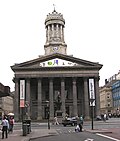
Scotland Street School Museum is a museum of school education in Glasgow, Scotland, in the district of Kingston. It is located in a former school designed by Charles Rennie Mackintosh between 1903 and 1906. The building is one of Glasgow's foremost architectural attractions. It is located next to the Shields Road subway station. The building features in the video of the Deacon Blue song Dignity and also in the video of the Billy Mackenzie song “Baby”.
